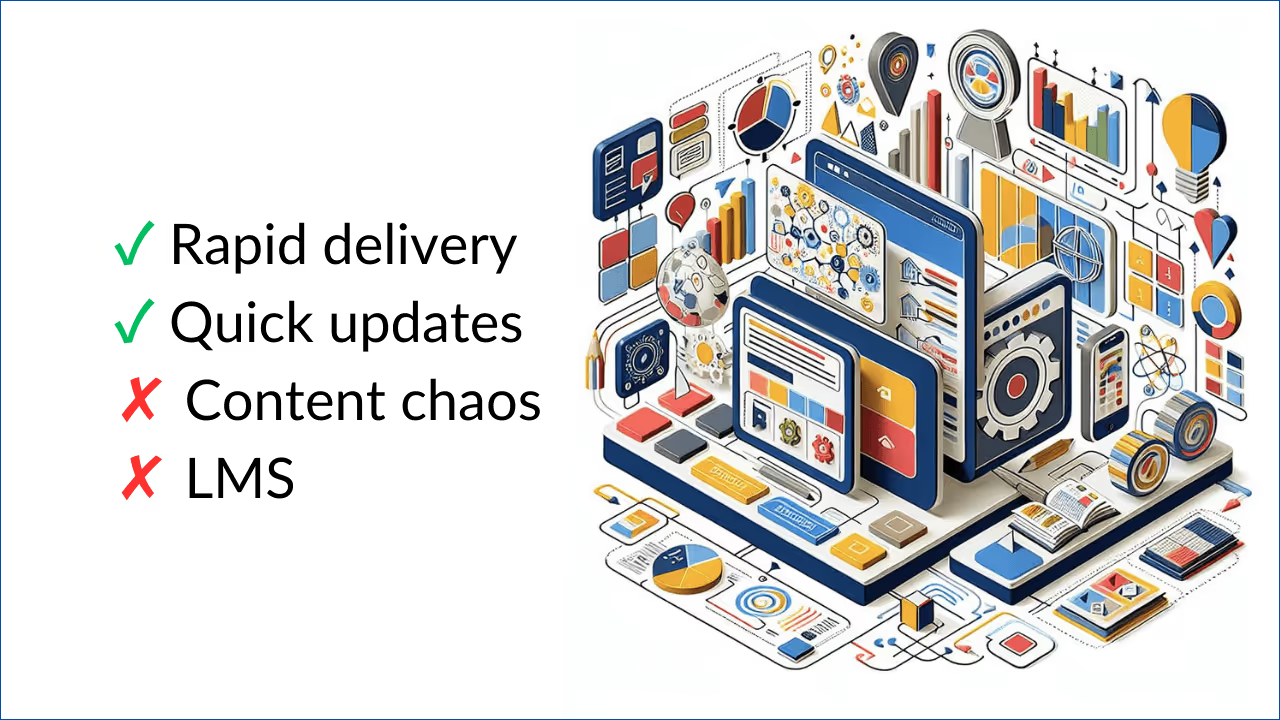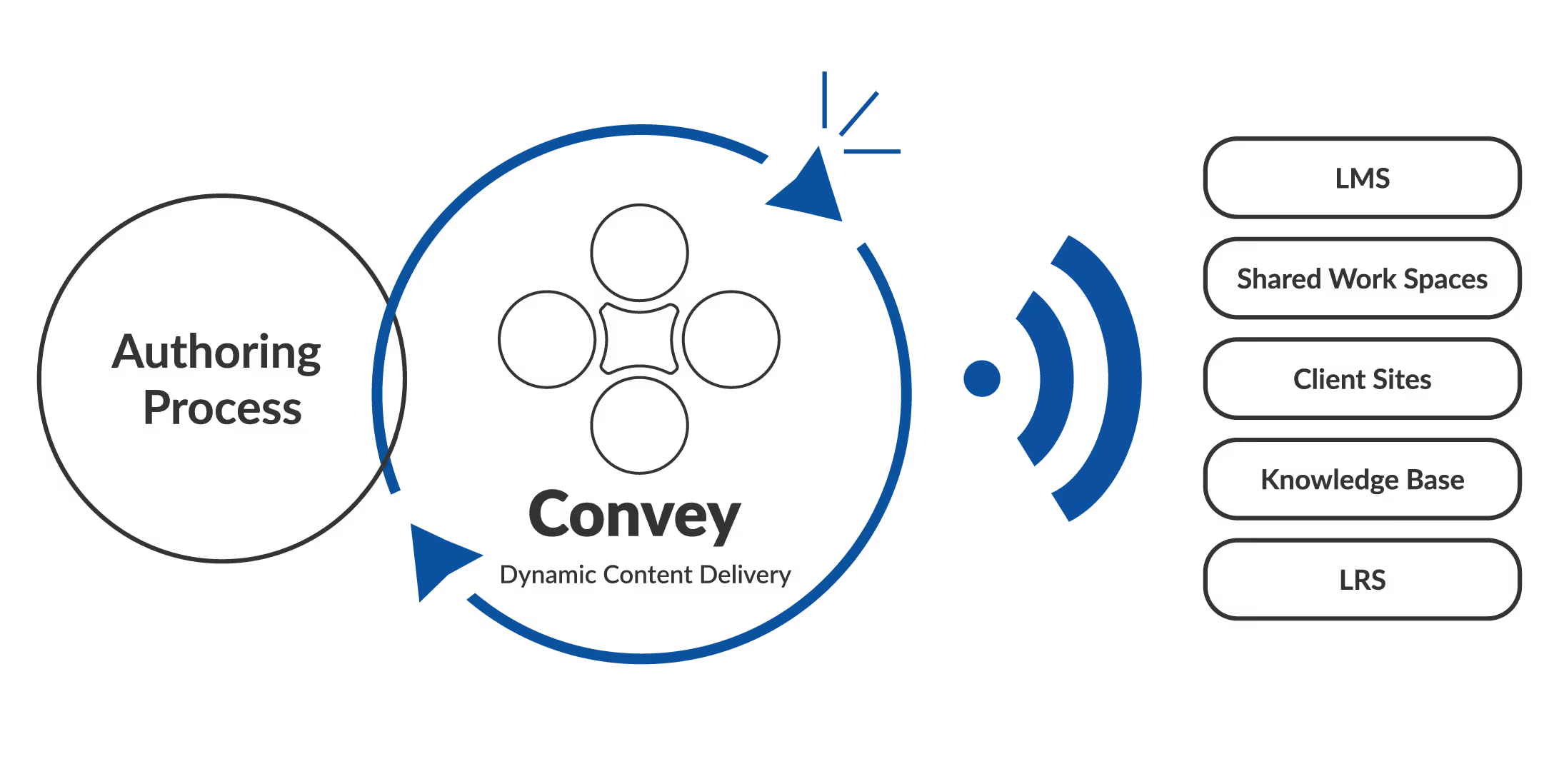A Smarter Way to Manage Training Outside an LMS



For organizations delivering learning without an LMS—or managing training content for external audiences outside of an LMS—keeping content updated can be a relentless challenge. Tracking everything, maintaining version control, and making countless edits and tweaks can feel never-ending. Just as you finish, it’s often time to do it all over again.
Supporting content outside your LMS doesn’t mean learning content management needs to be a struggle. In fact, there’s a surprisingly simple solution that will make your life a lot easier … and no, it has nothing to do with getting an LMS!
The problem with managing learning content outside an LMS
The traditional content management process is far from ideal for learning teams publishing content outside of an LMS. You will (hopefully) have a spreadsheet detailing where each version of your content exists, whether that’s on an intranet, on SharePoint, in an eCommerce catalog, on different customer platforms, on a website or natively within a product.
Every time you need to update a piece of eLearning – for example, to update product training in a support portal – it kick-starts a multi-step process to trawl through your documentation, find every single course, make the updates to the source files (or work with multiple platform owners to make the updates), then publish the new file version(s).
This, understandably, can take days, weeks. or even months. If you have to do this every single time you need to update a piece of content, it’s easy to see how fast this process can become unmanageable.
There are all sorts of reasons you may need to update your eLearning content, including:
- Replacing outdated information (such as changing industry regulations)
- Adding new information (such as a new product line)
- Updating branding (following a company rebrand)
- Fixing typos or other errors
- Swapping out broken links or images
- Improving content based on learner feedback
If you spot a typo or a broken image in an eLearning course, and you face the traditional content updating process, it can be very tempting to let it slide until you have enough issues to make the effort worth it… but if this is part of a customer training program, how will these little errors affect the way they perceive the value of your product? And what happens when the inconsistencies between versions start adding up?
There’s a better way to manage your content!
Introducing dynamic content delivery
Even if you’re not using an LMS, you can still benefit from the efficiency of dynamic content delivery.
Dynamic content delivery means you can edit source content once, and update every single existing copy, no matter where they’re hosted, at the touch of a button.
That’s right – no need to painstakingly edit, reupload, and republish tens or hundreds of versions of the same eLearning course. Simply update your existing publish targets, then updates are sent to the live link, whether they live on your internal systems or on customer platforms.
So, how does it work? It’s surprisingly simple: using a self-hosted “web package,” dynamic content delivery allows you to use a dynamic link, not a static file, on each platform. Think of it like accessing a Google Doc, which can be updated in real time, vs a static text document, which needs to be reuploaded and republished every time a new version is created.
Then, with a single click, any edits made to the source files can be published instantly, to your course, wherever it lives.
A dynamic publishing service can reduce the time spent finding, posting, updating, and maintaining informal learning content by as much as 90%.
Is dynamic content delivery really suitable if I don’t have an LMS?
It can often surprise learning teams who use content outside an LMS, as well as inside it, that dynamic content delivery is a viable option for both delivery methods. In fact, almost all of the time, it’s a significantly better option than the traditional method of content delivery, and it pays higher dividends the more content you have to support!
Dynamic content delivery is suitable for everything from full eLearning courses to job aids, and from instructor-led materials to just-in-time performance support assets. Maybe you email them to learners on an ad hoc basis, or they’re stored on SharePoint, or they’re available directly within your HR system, or are hosted and sold on a website.
Traditional learning content management, where you upload static files, results in a nightmare of spreadsheets and manual processes to track content consumption if you’re hosting content outside the LMS, while an LCMS and dynamic content delivery can take care of the entire content management and tracking process for you. With the LCMS you’ll have ways to better organize your content, reports that can help confirm if content was updated since the last publish, and with Dynamic Delivery, your distribution process will be made painless.
These aspects are particularly useful for organizations with limited content manager or webmaster resources. For these businesses, dynamic content delivery puts the power into the hands of the content authors themselves, making them much more self-sufficient by allowing them to share new and updated content instantly, no matter where the eLearning content is accessed.
Can I measure engagement with dynamic content delivery, even without an LMS?
With traditional eLearning content delivery, it can be challenging to track and measure learning that takes place. You’re usually reliant on a collection of disparate tools to report back with your data, if you even bother going to that length at all, leading to inconsistencies and patchy reporting.
With a dynamic content delivery engine, you can see how many learners are accessing a piece of content online, even without an LMS or LRS. This helps you understand if the content is useful and being visited, and can give you an insight into the way learners are engaging with your learning content.
If you need even more information, you can either connect to Google Analytics or if you have an Learning Record Store (LRS) launch the package as an xAPI web link and get even more details about the learning experience.
What’s the best dynamic content delivery tool for companies to support informal learning effectively?
Convey is dominKnow’s dynamic content delivery tool. It streamlines the learning content distribution process by allowing your authoring team to quickly get content updates online, whether that’s on your knowledge base, intranet, website or otherwise, without being reliant on webmasters or content managers to publish content to their final destinations.

“Using dominKnow | ONE and Convey reduced content development time from 3-6 months to weeks. We used to spend 90% of our time maintaining content and searching for content requiring updates somewhere across our LMS or SharePoint workspace. Now we can update content instantly without having to track it down. Simple and efficient.”
Ed Hjorth, Digital Content Lead, MicroFocus (an OpenText company)
With Convey, any organization managing learning content outside of an LMS can speed up the content distribution processes, no matter what or how many platforms are being used to house web content. It’s ideal for any business hosting learning content on shared workspaces, customer platforms, knowledge bases, websites or directly within products as just-in-time job aids.
Keeping web learning experiences up to date is significantly streamlined thanks to Convey’s hosting server. It provides a web-accessible destination where content is hosted, giving organizations without their own LMS total flexibility over where they share eLearning resources.
Convey also works seamlessly with the dominKnow | ONE Learning Content Management System (LCMS), which allows you to create, update and publish all your own content from a single authoring interface. Learning content templates mean you can create powerful learning resources at speed, and dominKnow | ONE’s single-source content approach enables you to create content once and reuse it in a multitude of formal and informal formats.
When all of your formal and informal learning content is ready to go, you can publish it all simultaneously, and the updates will be reflected in every single instance of the content thanks to the SCORM stubs or web packages. There’s no duplication of effort required, making it just as quick and easy to publish a single eLearning course to a website as it is to update that same course 500 times across various knowledge bases, customer sites, intranets, file systems and more.
Convey is the best dynamic content delivery tool for everyone from small businesses with one-person L&D teams to large multinational organizations delivering learning to thousands of customers worldwide, as you don’t need an LMS to update and publish eLearning content with ease.
How a Convey user easily publishes learning as website content
A large financial institution sought a replacement for its legacy LCMS, requiring high customization and support for HTML, JavaScript, and xAPI data. They selected dominKnow | ONE due to its powerful content creation capabilities and the ease of content distribution with Convey.
The Convey dynamic publishing and hosting service allowed the client to provide a wide range of content to its learners through structured, formal self-study learning programs, which can be easily edited and updated in real-time without the need for uploading new SCORM files, and informal access to self-study learning programs. For the self-study programs, the client publishes the same courses to Convey as Public Share Links (instead of SCORM) to create website versions, with content updates automatically available when they are published to the same link.
Convey's dynamic publishing and hosting service enabled the client to provide a wide range of content through structured, formal self-study programs, which can be edited and updated in real-time without needing to upload new SCORM files. For informal self-study programs, the client publishes courses to Convey as Public Share Links, creating website versions with automatic content updates.
“Convey was huge for us because we could make edits without having to replace and republish a SCORM file each time. If we had to replace a SCORM file, that was a multi-week process. Especially when it’s just to update a spelling error or something simple like that it was lengthy, and cost-prohibitive. Now, with dominKnow | ONE’s dynamic content delivery platform, Convey, we don’t have to go through that process.”
Ready to see Convey in action? We’d love to show you how it works for organizations who don’t use an LMS, and why it’s such a great alternative to traditional learning content delivery. Schedule your demo today!
Related Resources
.avif)
New to IDIODC?
Instructional Designers in Offices Drinking Coffee (#IDIODC) is a free weekly eLearning video cast and podcast that is Sponsored by dominknow.
Join us live – or later in your favourite app!



.svg)






